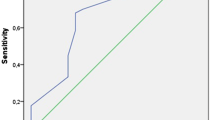Abstract
The objective is to compare immediate and delayed SWL as a treatment for ureter stones between 5 and 20 mm. Patients who applied to the emergency department with single, radio opaque ureteric stone of 5–20 mm size were included in the study. Patients were randomized into immediate and delayed SWL groups. SWL were carried out after pain relief in the delayed group. Maximum of three SWL sessions were applied to the patients with stones of 5 mm or bigger in diameter, leaving at least 3 days interval in-between. Stone-free rate after first session was similar in two groups. When CIRF was also considered as success, the success rate of SWL in the immediate SWL group was higher after first session (p = 0.02). Immediate SWL had a greater success rate in upper ureteric stones (p = 0.019). Overall average time required for elimination of stones was shorter in immediate SWL group than delayed SWL group (p = 0.033). The success rate after first SWL session (including CIRF) was 59 % for patients with chronic pain in the delayed group and 100 % for patients with acute pain in the immediate group. According to the hydronephrosis grade, success rates were 71 and 44.4 % for patients with grade 1 or no hydronephrosis in the immediate SWL group, and for patients with grade 2 or larger hydronephrosis in the delayed SWL group, respectively, after first SWL session. Immediate SWL insures stone-free status in a shorter time in cases with renal colicky pain and ureteral stones, particularly upper ureteral stones.
Similar content being viewed by others
Abbreviations
- SWL:
-
Extracorporeal shock wave lithotripsy
- EAU:
-
European Association of Urology
- AUA:
-
American Urological Association
- PAR:
-
Plain abdominal radiographs
- URS:
-
Ureteroscopic lithotripsy
- PNL:
-
Percutaneous nephrolithotomy
- USG:
-
Ultrasonography
- NCCT:
-
Noncontrast computed tomography
- ER:
-
Emergency department
- VPS:
-
Visual pain scale
- CIRF:
-
Clinically insignificant residual fragment
References
Ghalayini I, Al-Ghazo M, Khader Y (2008) Evaluation of emergency extracorporeal shock wave lithotripsy for obstructing ureteral stones. Int Braz J Urol 34:433–442
Segura JW, Preminger GM, Assimos DG et al (1997) Ureteral Stones Clinical Guidelines Panel summary report on the management of ureteral calculi. The American Urological Association. J Urol 158:1915–1921
Tombolini P, Ruoppolo M, Bellorofonte C et al (2000) Lithotripsy in the treatment of urinary lithiasis. J Nephrol 13(Suppl 3):S71–S82
Preminger GM, Tiselius HG, Assimos DG (2007) Guideline for the management of ureteral calculi. Eur Urol 52:1610–1631
Azm TA, Higazy H (2002) Effect of diuresis on extracorporeal shockwave lithotripsy treatment of ureteric stones. Scand J Urol Nephrol 36:209–212
Mueller SC, Wilbert D, Thueroff JW et al (1986) Extracorporeal shock wave lithotripsy of ureteral stones: clinical experience and experimental findings. J Urol 135:831–834
Parr NJ, Pye SD, Ritchie AWS et al (1992) Mechanisms responsible for diminished fragmentation of ureteral calculi: an experimental and clinical study. J Urol 148:1079–1083
Doublet JD, Tchala K, Tligui M et al (1997) In situ extracorporeal shock wave lithotripsy for acute renal colic due to obstructing ureteral stones. Scand J Urol Nephrol 31:137–139
Joshi HB, Obadeyi OO, Rao PN (1999) A comparative analysis of nephrostomy, JJ stent and urgent in situ extracorporeal shock wave lithotripsy for obstructing ureteric stones. BJU Int 84:264–269
Kravchick S, Bunkin I, Stepnov E et al (2005) Emergency extracorporeal shockwave lithotripsy for acute renal colic caused by upper urinary-tract stones. J Endourol 19:1–4
Tombal B, Mawlawi H, Feyaerts A et al (2005) Prospective randomized evaluation of emergency extracorporeal shock wave lithotripsy (ESWL) on the short-time outcome of symptomatic ureteral stones. Eur Urol 47:855–859
Seitz CFH, Remzi M, Waldert M et al (2006) Rapid extracorporeal shock wave lithotripsy treatment after a first colic episode correlates with accelerated ureteral stone clearance. Eur Urol 49:1099–1105
Seitz C, Tanovic E, Kikic Z et al (2007) Rapid extracorporeal shock wave lithotripsy for proximal ureteral calculi in colic versus noncolic patients. Eur Urol 52:1223–1227
Kumar A, Mohanty NK, Jain M et al (2010) A prospective randomized comparison between early (<48 h onset of colicky pain) versus delayed shockwave lithotripsy for symptomatic upper ureteral calculi: a single center experience. J Endourol 24(12):2059–2066
Kriegshauser JS, Carroll BA (1991) The urinary tract. In: Rumack CM, Wilson SR, Charboneau JW (eds) Diagnostic ultrasound, Mosby Year Book, St.Louis, p 242
Robert M, Delbos O, Guiter J et al (1995) In situ piezoelectric extracorporeal shock wave lithotripsy of ureteric stones. Br J Urol 76:435–439
Farsi HM, Mosli HA, Alzimaity M (1994) In situ extracorporeal shock wave lithotripsy for primary ureteric calculi. Urology 43:776–781
Seitz C, Fajkovic H, Waldert M et al (2005) Extracorporeal shock wave lithotripsy in the treatment of proximal ureteral stones: does the presence and degree of hydronephrosis affect success? Eur Urol 49:378–383
Demirbas M, Kose AC, Samli M et al (2004) Extracorporeal shock wave lithotripsy for solitary distal ureteral stones: does the degree of ureteral obstruction affect success? J Endourol 18:237–240
Zagoria RJ, Khatod EG, Chen MYM (2001) Abdominal radiography after CT reveals urinary calculi: a method to predict usefulness of abdominal radiography on the basis of size and CT attenuation of calculi. AJR 176:1117–1122
Tligui M, El Khadime MR, Tchala K et al (2003) Emergency extracorporeal shock wave lithotripsy (ESWL) for obstructing ureteral stones. Eur Urol 43:552–555
Author information
Authors and Affiliations
Corresponding author
Rights and permissions
About this article
Cite this article
Uguz, S., Senkul, T., Soydan, H. et al. Immediate or delayed SWL in ureteric stones: a prospective and randomized study. Urol Res 40, 739–744 (2012). https://doi.org/10.1007/s00240-012-0490-2
Received:
Accepted:
Published:
Issue Date:
DOI: https://doi.org/10.1007/s00240-012-0490-2




